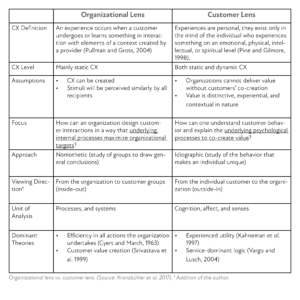Customer Experience: A Tale of Two Opposing Views
May 2, 2019One may not assume that a customer perceives a ‘customer experience’ as was intended by the provider. Conversely, an experience that is favorable for the customer does not always contribute a company’s performance. The challenge is to unite both perspectives.
Anno 2019, Customer Experience or ‘CX’ is omnipresent. The CX concept was introduced in 1982 by Holbrook and Hirschman as a holistic construct. In the meantime, both academics and practitioners believe that a favorable customer experience not only positively impacts customer satisfaction, customer loyalty, and word-of-mouth behavior – something customers themselves have known all along – but that it also is a compelling precursor of the much-coveted competitive advantage.
Despite this consensus, the CX concept remains foggy because the holistic construct has diverged into two mostly unconnected schools of thought. The main reason is that academics and practitioners tend to look at customer experience through one of two opposing lenses. One is the organizational lens and the other is the customer lens. This is one of the conclusions of a review of customer experience research since 1982 drawn by Kranzbühler et al. (2017).
The one who looks through the organizational lens assumes that experiences can be designed and that all customers will perceive stimuli alike. The one viewing through the customer lens ascertains that firms cannot deliver value since the customer is always a co-creator of value. While the former focuses on organizational structure, strategy, and customer-employee interactions, the latter considers individual customer journeys, cognition, affect, and senses.
Static and Dynamic Customer Experiences
A distinction is made between static and dynamic customer experiences. A static CX describes how an individual evaluates one or more touchpoints with an organization on a cognitive, affective, and sensory level at one specific point in time. A dynamic CX considers the evolving cognitive, affective, and sensory evaluation throughout the entire customer journey.

The organizational lens points to the design of static CX and to the management of dynamic CX, yet the focus on static CX tends to dominate. The customer lens analyzes customers’ perceptions in three planes: the static CX itself; how dynamic CXs are formed; and how cognition, affect, and the senses impact both static and dynamic CXs.
- The organizational lens focuses on what is within a company’s control; the customer lens looks at the whole picture.

As one can see, the famous customer journey is a key component of the customer lens. The ultimate goal of a customer journey is to “teach companies more about their customers in order to market better, sell faster and serve more effectively” (Milbrath, 2019). Being taught requires a willingness to learn and to shift to an outside-in view. Only then can one look inside one’s own processes and, with lessons learned from customers, improve them to match expectations.
Yet most organizations fail to truly master the art of customer journey mapping. Three reasons account for this fact. First, looking through the wrong lens sets one up for failure. Very few answers can be found in one’s navel.
- The one who’s usually left out of the customer journey mapping process is the one with the answers: the customer.
Secondly, the proliferation of touchpoints, channels, and offerings makes a customer journey non-linear, unclear, and unpredictable.
- The VUCA-world leaves most of us wandering around blind. Yet, nearly all answers are in plain sight outside.
Thirdly, in this day and age of big data, data still is unable to capture the emotions and feelings of customers.
- Organizations must develop, hire, or acquire the skills to turn an abundance of data into actionable behavioral insight and ditto foresight.
A study from the CMO Council published in 2016 among the top 150 senior marketers throughout Europe and the U.S. revealed that “only 5% of marketers say they have mastered the ability to adapt and predict the customer journey and what actions will derive maximum value.”
It can be done, and it takes two things to start
Among practitioners, the growing consensus is that one must look at the dynamic CX and not just at the static. Moreover, it takes the entire organization to support the customer journey. Two precursors to CX success are:
- You must know who your primary customers are
- You must develop a customer mindset
The first is the select group of people who unlock most value for your organization. The second is “vital to providing a consistent service that meets customers’ changing needs” (Brown, 2015).
- The two lenses need to merge: A successful, agile organization is interdependent from customer success. And customer success comes from deep behavioral insight and foresight.
To end with my mantra once again: “Customer behavior defines the organization; technology enables it, makes it efficient and scalable. Yet only hyper-relevance engages both customers and employees.”
References
Brown, L.R., and Brown, C.L., 2015. The Customer Culture Imperative: A Leader’s Guide to Driving Superior Performance. New York: McGraw-Hill Education.
CMO Council, 2016. Predicting Routes to Revenue: Identifying Real-Time Decisions for Business-Driving Engagement (White paper). San Jose, CA: CMO Council.
Kranzbühler, A-M., Kleijnen, M.H.P., Morgan, R.E., and Teerling, M., 2017. The Multilevel Nature of Customer Experience Research: An Integrative Review and Research Agenda. Oxford: International Journal of Management Reviews, British Academy of Management and Jon Wiley & Sons Ltd.
Milbrath, S., 2019. The fundamental flaw in customer journey mapping—and how to fix it. [online] Vision Critical Communications, Inc. Available at <https://www.visioncritical.com/blog/customer-journey-mapping> [Accessed 22 March 2019].


